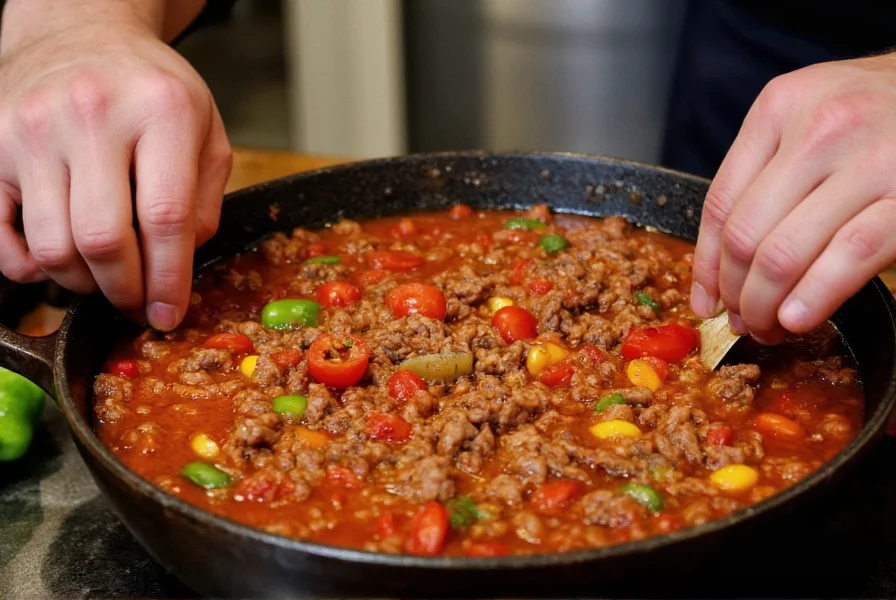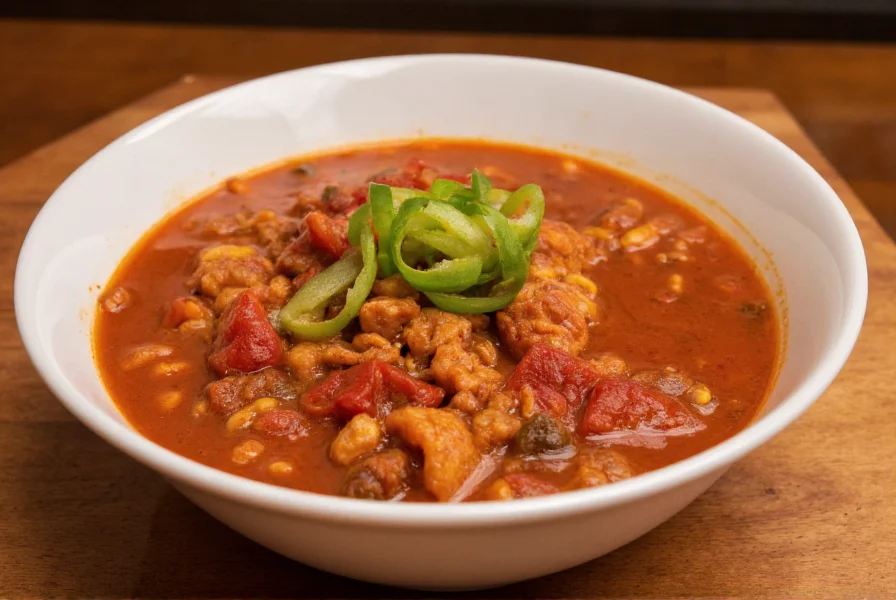For centuries, chili soup has evolved from its indigenous Mesoamerican roots into one of America's most beloved comfort foods. What began as a simple combination of wild chilies and game meat has transformed into countless regional variations, each with distinctive characteristics that reflect local ingredients and culinary traditions.
The Rich History of Chili Soup
Chili's origins trace back to pre-Columbian Mexico, where indigenous peoples combined chili peppers with tomatoes and meat. Spanish colonists later introduced cattle, creating the foundation for modern chili con carne. By the 19th century, chili had become a staple among cowboys and settlers in Texas, who cooked it in cast-iron pots over open fires during cattle drives.
The dish gained national prominence when it was served at the 1937 Texas Centennial Exposition in Dallas. Today, chili competitions across the United States celebrate regional variations, from the bean-free "bowl of red" favored in Central Texas to the Cincinnati-style chili served over spaghetti in Ohio.
Essential Ingredients for Authentic Chili Soup
Creating exceptional chili soup requires careful selection of ingredients that work in harmony. While recipes vary, certain components form the foundation of great chili:
| Ingredient Category | Recommended Options | Why It Matters |
|---|---|---|
| Meat | Chuck roast, brisket, ground beef (80/20) | Higher fat content creates richer flavor and tender texture |
| Chili Peppers | Ancho, guajillo, chipotle, fresh jalapeños | Each contributes unique flavor notes beyond just heat |
| Tomato Base | Crushed tomatoes, tomato paste, fire-roasted | Provides acidity and depth; paste enhances umami |
| Beans (optional) | Pinto, kidney, black beans | Adds heartiness; traditional in some regions, excluded in others |

Classic Beef Chili Soup Recipe
This traditional recipe serves 6-8 people and requires approximately 2.5 hours of cooking time, including preparation. The extended simmering time is crucial for developing complex flavors.
Ingredients
- 2 lbs beef chuck, cut into 1/2-inch cubes
- 3 tbsp chili powder (preferably homemade blend)
- 2 tbsp ground cumin
- 1 tbsp smoked paprika
- 2 medium yellow onions, finely diced
- 4 cloves garlic, minced
- 28 oz crushed tomatoes
- 15 oz pinto beans, drained and rinsed
- 4 cups beef broth
- 2-3 fresh jalapeños, seeded and minced
- 2 oz dark chocolate (70% cacao)
- Salt and freshly ground black pepper to taste
Step-by-Step Preparation
- Brown the meat: Heat 1 tbsp oil in a heavy pot over medium-high heat. Working in batches, brown the beef cubes on all sides. Remove and set aside.
- Build flavor base: In the same pot, sauté onions until translucent (about 5 minutes). Add garlic and fresh jalapeños, cooking for 1 minute until fragrant.
- Toast spices: Stir in chili powder, cumin, and paprika. Cook for 1-2 minutes until aromatic, being careful not to burn.
- Combine ingredients: Return beef to pot. Add crushed tomatoes, beans, beef broth, and 1 tsp salt. Bring to a gentle boil.
- Simmer: Reduce heat to low, cover partially, and simmer for 1.5-2 hours until meat is tender and flavors are well integrated.
- Finish: Stir in dark chocolate and additional salt to taste. Simmer 10 minutes more.
Variations for Different Dietary Preferences
Modern chili soup accommodates various dietary needs while maintaining authentic flavor profiles:
- Vegetarian chili soup: Substitute meat with portobello mushrooms, sweet potatoes, and extra beans. Use vegetable broth and add 1 tbsp soy sauce for umami depth.
- Texas-style chili: Omit beans and tomatoes for a meat-forward version focusing on dried chili peppers and spices.
- White chicken chili soup: Use chicken thighs, white beans, green chilies, and tomatillos for a lighter alternative.
- Instant Pot chili soup: Reduce cooking time to 35 minutes with pressure cooking while maintaining flavor development.

Professional Cooking Techniques for Superior Chili Soup
Mastering chili soup requires understanding key culinary principles that transform good chili into exceptional chili:
- Dry toast whole spices: Before grinding, toast whole cumin seeds and dried chilies in a dry skillet for 2-3 minutes to enhance flavor complexity.
- Layered heat management: Use multiple chili varieties with different Scoville ratings to create nuanced heat rather than relying on a single hot pepper.
- Acidity balance: Finish with a splash of apple cider vinegar or fresh lime juice to brighten flavors that may have mellowed during cooking.
- Resting period: Allow chili to rest overnight; flavors continue to develop and integrate as it sits.
- Texture control: For thicker chili, remove lid during final 30 minutes of cooking. For thinner consistency, add additional broth.
Nutritional Profile and Health Benefits
A typical serving (1.5 cups) of traditional beef chili provides:
- Approximately 320 calories
- 24g protein
- 15g dietary fiber (when including beans)
- Rich in iron, vitamin C, and antioxidants from chili peppers
The capsaicin in chili peppers offers several health benefits, including metabolism boost and anti-inflammatory properties. Beans contribute sustained energy through complex carbohydrates, while tomatoes provide lycopene, a powerful antioxidant.
Storage and Reheating Guidelines
Proper storage maintains chili's quality and ensures food safety:
- Cool completely within 2 hours of cooking
- Store in airtight containers for up to 4 days in the refrigerator
- Freeze for up to 6 months in portion-sized containers
- Reheat on stove over medium-low heat, stirring occasionally
- Add small amounts of broth when reheating to restore ideal consistency
Common Mistakes to Avoid When Making Chili Soup
Even experienced cooks sometimes make these chili preparation errors:
- Rushing the cooking process (chili needs time for flavors to develop)
- Using low-quality chili powder (opt for fresh, high-quality spices)
- Adding all spices at once rather than layering them throughout cooking
- Overlooking the importance of proper meat browning
- Seasoning only at the end rather than building seasoning throughout
Perfect Pairings for Your Chili Soup
Elevate your chili experience with these complementary sides and toppings:
- Cornbread with honey butter
- Avocado slices or guacamole
- Sour cream or Greek yogurt
- Shredded cheddar or Monterey Jack cheese
- Fresh cilantro and lime wedges
- Simple green salad with vinaigrette
Frequently Asked Questions
What's the difference between chili and chili soup?
Chili typically refers to the thicker, heartier dish often served as a main course, while chili soup has a brothier consistency. The distinction is regional and somewhat subjective, with many considering them interchangeable terms. Traditional Texas chili contains no beans and has a meat-forward consistency, while Midwestern versions often include beans and tomatoes for a soup-like texture.
How can I reduce the spiciness of chili soup without compromising flavor?
To mellow excessive heat, add dairy products like sour cream or yogurt, which contain casein that neutralizes capsaicin. Acidic ingredients such as lime juice or vinegar can also balance heat perception. For future batches, toast dried chilies gently before using them, as this reduces heat while preserving flavor. Remember that chili's heat often mellowes as it sits overnight.
Why does my chili soup taste bland and how can I fix it?
Bland chili usually results from insufficient seasoning layers or low-quality spices. Fix it by adding small increments of salt, acid (like vinegar), and umami boosters (tomato paste or soy sauce). Toasting whole spices before grinding them releases more flavor compounds. Remember to season throughout the cooking process, not just at the end. A small amount of dark chocolate or coffee can also deepen flavor complexity.
Can I make authentic-tasting chili soup in less time?
While traditional chili benefits from slow cooking, you can create flavorful chili soup more quickly using an Instant Pot (about 35 minutes total) or by finely dicing ingredients to increase surface area for faster flavor development. For best results, use high-quality chili powder, toast your spices, and finish with fresh ingredients like lime juice and cilantro to add brightness that would otherwise develop during long simmering.
What makes restaurant-quality chili soup different from homemade versions?
Professional kitchens often use techniques like making their own chili powder blend from toasted whole chilies, incorporating umami boosters like fish sauce or soy sauce in small amounts, and using meat with higher fat content. They also typically cook chili for extended periods (sometimes 24+ hours) and allow it to rest before serving. The secret ingredient many restaurants use is a small amount of espresso or dark chocolate, which deepens flavor without making the chili taste like coffee or chocolate.











 浙公网安备
33010002000092号
浙公网安备
33010002000092号 浙B2-20120091-4
浙B2-20120091-4